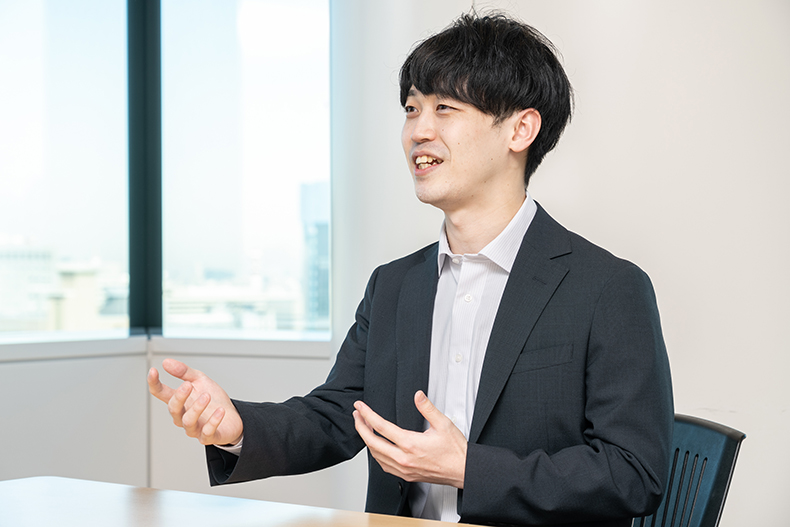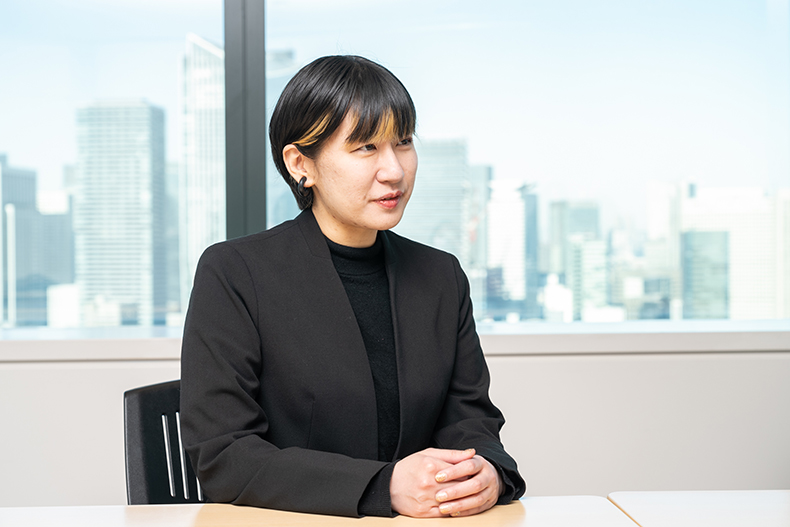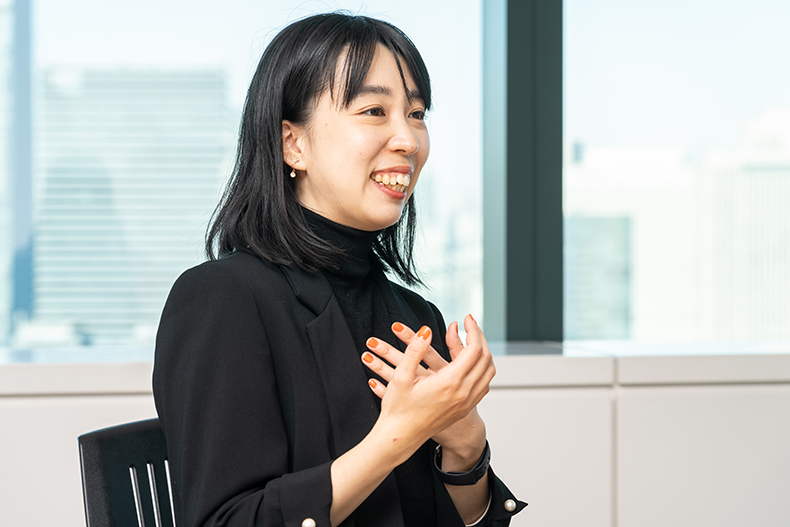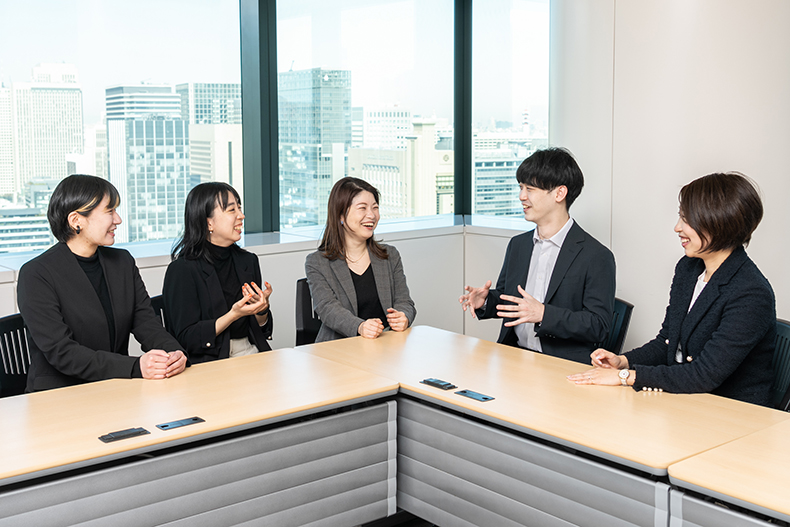- Table of Contents
Making more effective use of Gurunavi’s valuable big data on restaurants
- Please tell us what Gurunavi does.
Ms. Hikari Ito, Gurunavi: For more than 25 years, we have been involved in a variety of activities that include providing management support for the food service industry. Our restaurant information website Gurunavi is one example. In 2021, Gurunavi put forth “Food: Satisfying People and Creating Connections” as its new company Purpose. In line with this, our department is executing marketing and promotion projects that utilize Gurunavi’s restaurant network to link government, food manufacturers, and other companies and revitalize the entire food industry.
 Ms. Hikari Ito
Ms. Hikari ItoDeputy Section Manager, Product Planning Section, Promotion Planning Department, Promotion DivisionGurunavi, Inc.
Ms. Emi Yamamoto, Gurunavi: We have accumulated a vast amount of data. This data includes menus, prices, and other items that restaurants register on their managed screens, as well as behavioral data that comes from consumers who conduct searches and make reservations. We use it to help food manufacturers develop products, for example. However, although we analyze restaurant data, we felt we were not making full use of our data for various reasons. Among them were the fact that conducting analyses crossed with other data is difficult, and that using commercially available analytical tools was very time-consuming and often did not allow us to conduct analyses as we would have liked.
- What led you to undertake this project?
Mr. Masao Terashima, Fujitsu: We first met Gurunavi at a hackathon held in Tokyo last year. We developed a prototype of an app that uses data to help people open restaurants, and Gurunavi provided us with feedback from their vantage point as food professionals.
Ms. Shizuka Ito, Fujitsu: We learned then that Gurunavi possesses a vast amount of data. And we thought that by using it, we could help Gurunavi achieve its aim of supporting restaurant management.
Ms. Ito, Gurunavi: We were very grateful to Fujitsu for approaching us. Ordinarily, sales data from supermarkets, convenience stores, and other retailers is easy to handle because POS data linked to JAN codes (product identification codes) is available. However, collecting data from restaurants, of which many are private stores, is difficult. We are probably the only company that has quantified price data for each menu item.
We have been using this data in our business with the government and food manufacturers, but we felt that there might also be other ways we can utilize it. Fujitsu’s store app to support restaurant openings is a very interesting initiative that reflects the opinions of its employees. Indeed, it includes views that could only come from people who are not food experts. So we thought that if our two companies worked together, we could tackle challenges facing the entire food industry.
Testing a hypothesis with flexible thinking and speedy analysis
- You also utilized data that did not belong to Gurunavi in this project, right?
Mr. Terashima, Fujitsu: We conducted our analysis by combining data from Google Trends (information on keywords that we looked up on Google), which is publicly available as open data, retail price trend data, and POS data for the past five years (specifically, data on what was sold when and at what price) provided by Nikkei with Gurunavi’s data. Gurunavi provided us with time-series data on stores and prices by menu item, region, and business category as well as consumer search data.
 Mr. Masao Terashima
Mr. Masao TerashimaLarge Data Platform Business, Digital Shift, Fujitsu Uvance
Fujitsu
Ms. Mai Yamaoka, Gurunavi: We provided several hypotheses for the analysis. One was that “the menu items popular at restaurants will become popular in the order of, first, individual restaurants, followed by cooking at home (meals prepared at home), and then ready-made meals (boxed lunches, prepared side dishes, take-out, etc.).” We knew that such a trend existed based on our own data. However, that we were able to analyze it from various perspectives by crossing it with POS and other data was significant.
Ms. Yamamoto, Gurunavi: We are presenting this hypothesis, which was substantiated as data, on the internet as a “Gurunavi Marketing Solution Case Study.” This particular case concerns Taiwanese sponge cake, but we have had about 50 menu items analyzed, not just this one. We have been working on this continuously for about six months.
 Ms. Emi Yamamoto
Ms. Emi YamamotoProduct Planning Group, Product Planning Section, Promotion Planning Department, Promotion Division
Gurunavi, Inc.
- How did you and Fujitsu communicate for those six months?
Ms. Yamaoka, Gurunavi: We held online meetings two or three times a month. We probably held more than twenty meetings in all. The online meetings went very smoothly. We had no problems at all. In fact, today is our first face-to-face meeting with the Fujitsu team. Their analysis was much faster than we had imagined, which really surprised us at first.
Mr. Terashima, Fujitsu: The kind of multivariate analysis that we performed for this project is usually highly time-consuming because of the many analysis processes required, such as preparation, integration, processing, and visualization. But we applied Fujitsu’s analysis platform and our knowledge of in-house analytical methods, which allowed us to proceed quickly.
Ms. Yamamoto, Gurunavi: Once, during a meeting, I asked, “Can you display something like this?” They responded right away by putting what I asked for on the screen. I was astonished by how fast they did that. It was completely different from our analyses using tools. They also presented us with different ideas, saying things like, “Why don’t we try this kind of analysis?” So I was also surprised by their creativity and flexibility. What they could not do on the spot, they worked on as an assignment for the next meeting.
 Ms. Mai Yamaoka
Ms. Mai YamaokaProduct Planning Group, Product Planning Section, Promotion Planning Department, Promotion Division
Gurunavi, Inc.
Mr. Terashima, Fujitsu: On the Fujitsu side, we suggested also looking at the matter in terms of cross-correlation and periodicity among time series. And if correlation and periodicity existed, we looked for and combined supporting data. For example, while sales of yokan(※1) bean jelly increased during the mid-year and year-end gift-giving seasons in the eating-at-home market, they increased during October in the food service market. We looked into this and found that October 8 is “Yokan Day” and that restaurants increased their handling of yokan as part of related events. From the data, we could see that, even if the menu item is the same, sales were approached differently by the eat-at-home and food service sectors.
- ※1yokan : yokan (Japanese jelly candy) is a Japanese confection made of red bean paste, agar, and sugar. It is usually sold in a block form, and eaten in slices.
Ms. Ito, Fujitsu: Various companies have probably utilized data in their product development and store opening strategies. But I think don’t many have crossed multiple forms of data in their analyses and made decisions based on the results. In our project, we successfully combined Nikkei’s data, open data, and various other forms of data under the theme of “food.” It’s a unique approach, I think.
 Ms. Shizuka Ito
Ms. Shizuka ItoBusiness Planning Manager, Large Data Platform Business, Digital Shift, Fujitsu Uvance (assignment at the time of the interview)
Fujitsu
Ms. Ito, Gurunavi: We also use analytical data to provide development consulting services for consumer and commercial products as part of our business. Recently, we’ve seen that trading companies, local governments, and other organizations that procure ingredients are also highly interested in food service data. Through this project, we combined our data with open data to find correlations with wholesale prices and the like and made price comparisons with the eat-at-home sector. We expect that further analysis will help us gain a more comprehensive view of the food industry, from ingredient procurement to consumers.
Supporting the building of a data-driven management platform, creating a food data platform in the future
- How can the results of this analysis be applied?
Ms. Yamaoka, Gurunavi: We substantiated one hypothesis concerning Taiwanese sponge cake. But we believe there are also different trends out there. Our approach will become even more interesting if we can pattern these trends and expand laterally to different menu items.
Ms. Yamamoto, Gurunavi: Gurunavi possesses content that has always been oriented toward predicting and publicizing trends. We anticipate that combining this content with a large volume of data, as we have done in this undertaking, can make it even stronger.
Ms. Ito, Gurunavi: If the amount of data used increases and more accurate data becomes available, we should be able to provide solutions that pay attention to data and spark food service-launched trends to food manufacturers and local governments desiring to revitalize their communities through agricultural products. A trend that begins must also end. So if we can use data to accurately predict trends or to keep trends going, we may be able to help eliminate the food loss that comes from excessive preparation.

Mr. Terashima, Fujitsu: We hear that many food manufacturers and major restaurant chains are analyzing internal data using spreadsheets on a monthly basis. But this is not just time-consuming; it also leads to such problems as the siloing of data and the individualization of know-how. If we can create a business application that integrates internal corporate data and, even more, Gurunavi’s restaurant data, and that constantly provides up-to-date cross-sections of that data, we will provide a tool that enables powerful, data-driven decision-making. I would like to see Fujitsu provide comprehensive assistance that does not just “analyze data and stop” but instead goes on to also sustain and utilize the data.
Ms. Ito, Gurunavi: I get the feeling that companies mainly focused on consumer-oriented business often refer to consumer-oriented advertising when they talk about using big data. I want them to know that the use of big data based on statistical analysis also exists, such as in this project.
Ms. Ito, Fujitsu: Eventually, I would like to see Fujitsu act as a link to create a foundation—something like a “food data platform”—together with companies that provide recipes and companies operating meal management apps that collect information on actual meals consumed. I think this will make it possible to provide even more value to end-user customers.
Ms. Yamaoka, Gurunavi: Recently, our data has become scattered across social media and the like, which I think makes expert assistance necessary. I think that, as a result of our partnership with Fujitsu, the use of our data could go beyond analysis to reach other types of businesses and industries. Ultimately, I hope we can develop it into something leading to sustainable “food” linked to the UN’s Sustainable Development Goals and the food industry’s overall optimization.
Mr. Terashima, Fujitsu: In this project, we combined data on restaurants with data from other sources. However, there are still few examples of efforts like ours to cross data possessed by different companies. We believe that progress toward overcoming various challenges will be made when data is connected across industries—not just the food industry—and linked as an ecosystem. This is something we will continue working toward.



